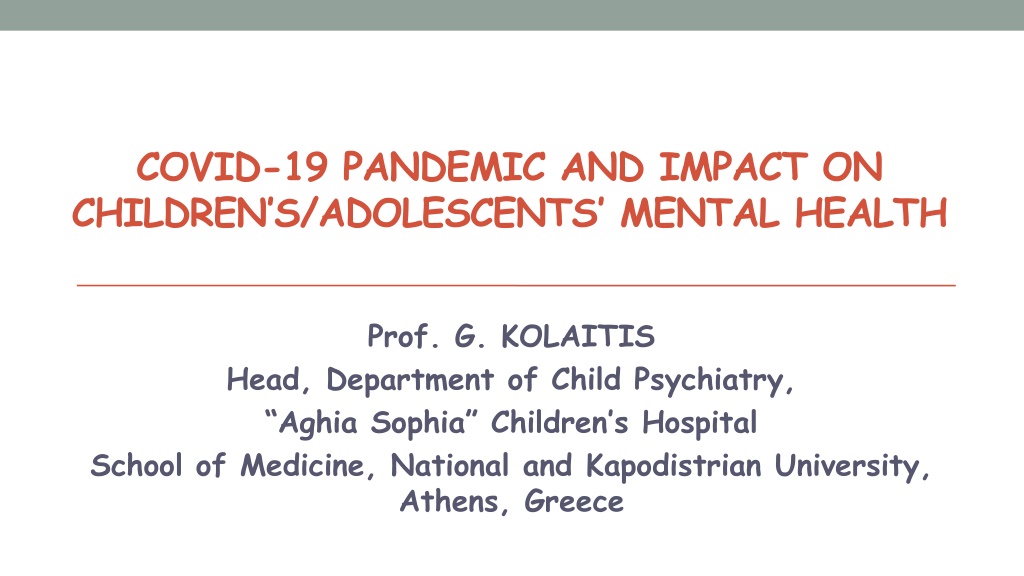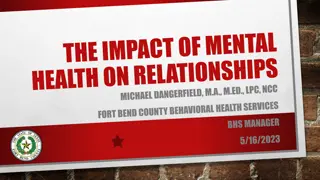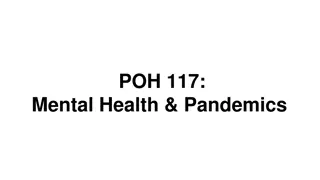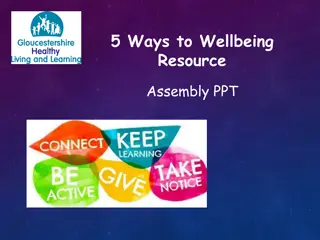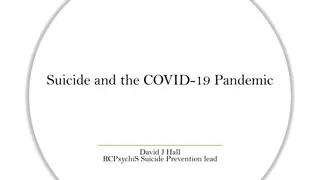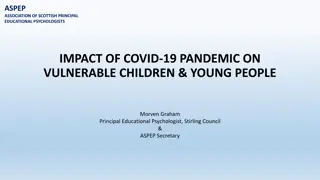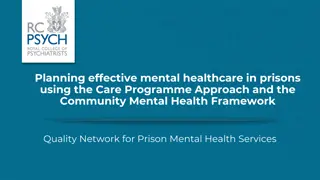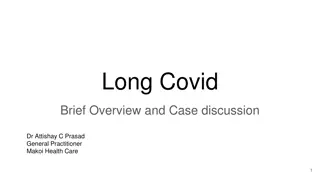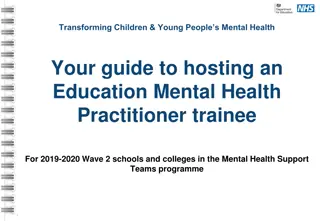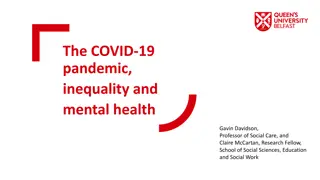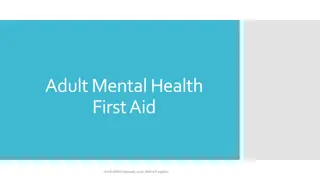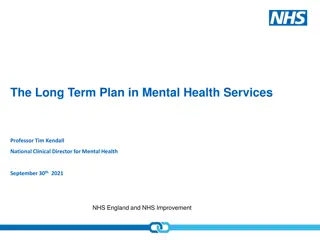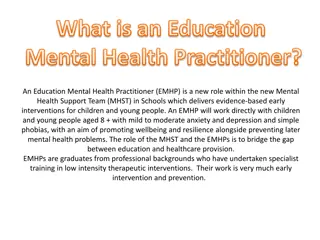Impact of COVID-19 Pandemic on Children's Mental Health
The COVID-19 pandemic has significantly impacted the mental health of children and adolescents worldwide, leading to concerns such as increased domestic violence, child abuse, and disruptions in mental health services. Studies show a negative impact on mental health, with issues like anxiety disorders, suicidal crises, and major depressive episodes being particularly affected. Telepsychiatry is being increasingly utilized to address the challenges posed by social distancing regulations.
Download Presentation

Please find below an Image/Link to download the presentation.
The content on the website is provided AS IS for your information and personal use only. It may not be sold, licensed, or shared on other websites without obtaining consent from the author. Download presentation by click this link. If you encounter any issues during the download, it is possible that the publisher has removed the file from their server.
E N D
Presentation Transcript
COVID-19 PANDEMIC AND IMPACT ON CHILDREN S/ADOLESCENTS MENTAL HEALTH Prof. G. KOLAITIS Head, Department of Child Psychiatry, Aghia Sophia Children s Hospital School of Medicine, National and Kapodistrian University, Athens, Greece
Covid-19 pandemic and mental health of children/adolescents Since the end of 2019, the coronavirus disease (COVID-19) outbreak rapidly became a pandemic SARS-CoV-2 is profoundly impacting lives of 1.6 billions of children and adolescents around the globe Isolation, contact restrictions and economic shutdown impose a complete change to our psychosocial environment Not many studies in the general population, especially on children/adolescents (Lee 2020) The first non-representative studies from China, India, USA, Spain, Italy, Germany show negative impact on mental health
Risks and concerns of patients, families and child and adolescent psychiatrists (ESCAP 2020) Domestic violence and child abuse might increase (extended periods of isolation within an abusive or unsafe home, less intense supervision from child protection services and lacking support from peers or schools) The economic crisis brought by the pandemic could have long-term negative consequences leading to increased family conflict, abuse, and substance abuse The pandemic is disrupting the normal bereavement processes of families Outcome of mental disorders could worsen because of delay in diagnosis/treatment Interventions to the whole family are much more difficult under these conditions Even for less severe patients, continuity of care is being disrupted as routine outpatient visits are being cancelled and postponed for safety reasons Telepsychiatry is increasingly being used to bridge the gap caused by social distancing regulations (despite ethical and technical questions)
Perceived impact of the COVID-19 pandemic on CAP services after 1 year (February/March 2021): ESCAP CovCAP survey While service delivery to patients and their families was affected in a major way (reported by 68%) at the beginning of the pandemic, the majority of respondents (59%) in this second survey only reported a minor impact on care delivery The use of telemedicine remained widespread (91%) but the proportion of CAP services partially closed or transformed to accommodate COVID-19 patients (59% in 2020) dropped to 20% The perceived impact on the mental health of children and adolescents dramatically increased from medium (> 50%) in 2020 to strong or extreme (80%) in 2021 4 conditions were particularly impacted: suicidal crises, anxiety disorders, eating disorders and major depressive episodes Associated with a substantial increase in referrals or requests for assessments (91% reported an increase in 2021 while 61% reported a decrease in 2020)
Impact of the COVID-19 pandemic on quality of life and mental health in children and adolescents in Germany (Ravens-Sieberer et al 2021) First national representative study in Germany Online study of n =1586 families with offspring 7-17y Measures: HRQoL (KIDSCREEN-10), mental health difficulties (SDQ), anxiety (SCARED) and depression (CES-DC). Comparison with BELLA cohort (n =1556) (before pandemic) 2/3 of children and adolescents were impacted by pandemic Significantly worse HRQoL (40.2% vs 15.3%), more mental health problems (17.8% vs 9.9%) and higher levels of anxiety (24.1% vs 14.9%) Greater pandemic impact on children of lower SES, immigrants and worse living conditions
Prevalence and socio-demographic correlates of psychological health problems in Chinese adolescents during the outbreak of COVID-19 (Zhou et al 2020) Cross-sectional on-line study of 8079 Chinese students 12-18y Symptoms of depression, anxiety and combination: 43.7%, 37.4%, and 31.3%, respectively Female gender and senior high school grade: risk factors for anxiety and depression symptoms Psychological symptoms were negatively associated with the level of awareness of COVID-19
An investigation of mental health status of children and adolescents in China during the outbreak of COVID-19 (Duan et al 2020) Online CDI, Coping Style Scale in 359 and 3254 adolescents High anxiety rates in children (23,87 15,79) and adolescents (29,27 19,79) 22.28% had depression symptoms 7 factors associated with increased anxiety e.g. females, urban resident, emotion-focused coping style 9 factors associated with increased depression e.g. smartphone addiction, Internet addiction, Hubei province resident 2 additional factors associated with lower depression e.g. hours spend on internet per day before pandemic and problem-focused coping style
Systematic reviews/meta-analyses of studies Increased risk for depression and mainly anxiety in adolescents, during and after lockdown (Loades et al, 2020) The prevalence of anxiety, depression, and stress was 29%, 37%, and 23% respectively (Wang et al, Sept 2021) Children and adolescents are experiencing significant anxiety and depression Adolescents, especially females and high school seniors, may be at greater risk Children who feel unsafe with regards to coronavirus disease 2019 may be more likely to experience somatic symptoms, depression, and anxiety Exposure to excessive information about COVID without parental communication on the topic may lead to higher anxiety and PTSD symptoms Social isolation, loneliness, lack of physical exercise, parenting stress and family stress may contribute to these problems Parental stress and mental health problems may put children at an increased risk for maltreatment (Meade 2021)
Effects of online homeschooling (remote learning) Well accepted despite teachers concerns Increased anxiety rates of parents and teachers, especially in primary education (Zhao et al 2020) 93.2% of students had no inattention during online schooling, 77.4% believed the same, but only 41.9% of teachers agreed 50% of parents believed that their offspring needed supervision but 37.1% of teachers believed they couldn t supervise students (Zhao et al 2020) 22% of families were burdened financially by remote learning Less routines, higher negative emotion and more concentration difficulties because of COVID-19 associated with more difficulties in remote schooling only in adolescents with ADHD (Becker et al 2020)
OUR STUDY: Aims Cross-sectional, on-line study Principal researchers: Zaravinos-Tsakos Ph, Giannakopoulos G and Kolaitis G Aims: To study children s and adolescents (8-17y) mental health, health related quality of life in relation to their parents trauma, quality of life, and family functioning during the second wave of COVID-19 pandemic
OUR STUDY: Sample/Measures N=772 (282 children, 490 adolescents) and their families Males=54.4%, mean age=11.83 (+/-2.72) COVID-19 Questionnaire Strengths and Difficulties Questionnaire (SDQ): completed by parents and adolescents 11-17y [comparison with Greek normative data] KIDSCREEN-27 for 8-18y (psychological and physical wellbeing, social support, autonomy, school environment) [comparison with European normative data] Global Psychotrauma Screen (GPS) [comparison with cross-cultural data] SF-12 of caregivers (physical and mental functioning) [comparison with Greek normative data] Family Assessment Device (FAD)-General Functioning
OUR STUDY: Preliminary results Increased emotional, conduct, hyperactivity, peer problems and decreased prosocial behaviors in adolescents Increased youngsters total psychopathology is significantly associated with age (adolescents), gender (boys), their psychological/physical wellbeing/social and peer support, stress due to restrictions and confinement; also with low family affluence, caregivers history of trauma and resilience, family dysfunction, loss of job due to pandemic Caregivers show better physical functioning and worse mental functioning High rates of family dysfunction (41.2%)
Conclusions The COVID-19 pandemic with its associated problems (e.g. restrictions, social isolation, loneliness, lack of physical exercise, parenting and family stress) has significantly impacted the lives, well being and mental health of children and adolescents as well as those of their families Current research (worldwide, ours) shows that children and adolescents show increased rates of emotional problems (e.g. anxiety and depression) Disadvantaged children and adolescents may be at even greater risk Health care professionals should screen for patients mental health needs (especially for depression and anxiety) and refer to mental health professionals when indicated More research, especially longitudinal, is needed
